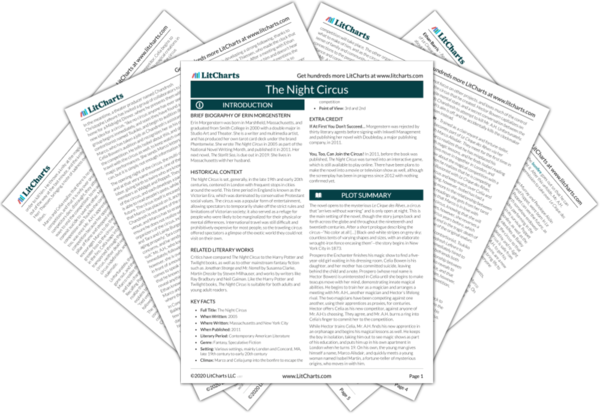Rivalry and Competition
At the center of The Night Circus is the competition between two young magicians, Celia and Marco, who must outperform each another with increasingly complex forms of magic until one of them dies. They do not fully understand the boundaries of this game, however, because they are only pawns, forced into competition by their teachers, Hector Bowen and Mr. A.H. Both of these aging magicians—who are not only teachers but also surrogate guardians…
read analysis of Rivalry and CompetitionLove
Despite the fact that they are meant to be competing against one another, young magicians Celia and Marco fall in love. Their love is a rebellion against the isolation imposed by their guardians, allowing them to collaborate and enhance the power of their magic. Celia and Marco embrace the vulnerability of an intimate connection in a way their guardians were never able to do. Where competition and rivalry lead only to isolation, love in the…
read analysis of LoveFamily, Community, and Belonging
The Night Circus presents an unconventional view of family structures, as most of the characters have, for one reason or another, separated from their biological families and adopted the circus as a de-facto family unit. Set in Victorian London, the novel reflects the fact that historically, the circus was known as a refuge for performers who were shunned for their differences or unique abilities and, in turn, looked to the circus community for acceptance and…
read analysis of Family, Community, and Belonging
Time and Mortality
The circus, as a place of leisure and youthful joy, is outside the reaches of time, presenting spectators with an uninterrupted present and a sense of immortality. In The Night Circus, however, that sense of eternal present is unsettling, as it makes time seem mysterious and uncontrollable. As Isobel explains about fortune telling, “The most difficult thing to read is time.” The novel touches on both the innate fear of death and loss, and…
read analysis of Time and MortalityMagic and Illusion
Le Cirque des Rêves differs from the typical circus show that presents spectacle and audience deception as lighthearted entertainment; instead, this circus is infused with actual magic, challenging spectators to question their perceptions of what is real. As a point of pride, the magician Mr. A.H. makes a strong distinction between magic, which is an art to him, and illusion, which he sees as meaningless and deceptive. In The Night Circus, however, circus…
read analysis of Magic and IllusionFreedom and Agency
Traditionally, the circus has enjoyed a reputation of freedom, as the performers were not bound by location or permanent family connections, and spectators could escape from the banality of their daily lives to the wonders of magic and spectacle. Yet, as the author notes in an epigraph from the novel, the word circus itself is derived “from the Greek kirkos meaning circle, or ring,” a shape that is designed to enclose or contain. The Night…
read analysis of Freedom and Agency






